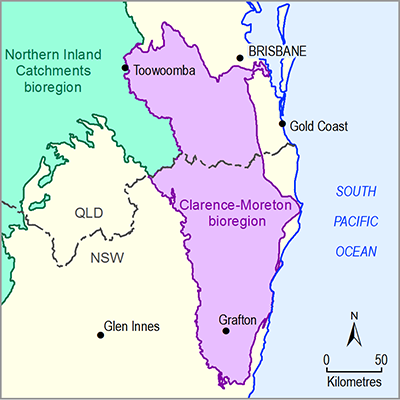The components of the water balance are not included in the uncertainty analysis reported in companion product 2.6.1 (Gilfedder et al., 2016) and 2.6.2 (Cui et al., 2016) for the Clarence‑Moreton bioregion. The water balance analysis was carried out based on 30 model simulations selected from a total of 3877 simulations conducted for the sensitivity analysis reported in companion product 2.6.2 (groundwater numerical modelling) for the Clarence‑Moreton bioregion (Cui et al., 2016). The sample size of 30 was used because it is commonly considered as the threshold sample size separating small-sample statistics from large-sample statistics (Davis, 2002). While the 30 samples will not provide the rigorous uncertainty analysis that is presented in companion product 2.6.1 (Gilfedder et al., 2016) and product 2.6.2 (Cui et al., 2016) for the Clarence‑Moreton bioregion, it is expected to provide a statistically significant estimate of the 10th, 50th and 90th percentiles of the water balance components. Losses are not able to be included in the estimation of water balance uncertainty because they would not form part of the hydrological response variables used should any impact and risk analysis be conducted.
The selection of suitable simulations and subsequent output analysis involved the following steps:
- Filter models using the forecast water production. Only models with a median annual water production that is within the range from one-tenth of the forecast volume to ten times the forecast volume were used for further analysis.
- Compute the head objective function (sum of squared residuals) using the observed heads described in companion product 2.6.2 for the Clarence‑Moreton bioregion (Cui et al., 2016).
- Compute the baseflow objective function (sum of squared residuals) using estimated baseflow at the river stage gauge site near Casino (CLM008) (Figure 3).
- Rank the models based on the sum of the two normalised components of the objective function described in step 2 and step 3.
- Conduct a statistical summary analysis using the top 30 models derived in step 4.
The computing approaches for various water balance terms are summarised in Table 3 and Table 4.
Table 3 Computing approaches of water balance terms in the surface water model for the Clarence‑Moreton bioregion
AWRA-L is the Australian Water Resources Assessment landscape model
Table 4 Computing approaches of water balance terms in the groundwater model for the Clarence‑Moreton bioregion
CSG = coal seam gas

